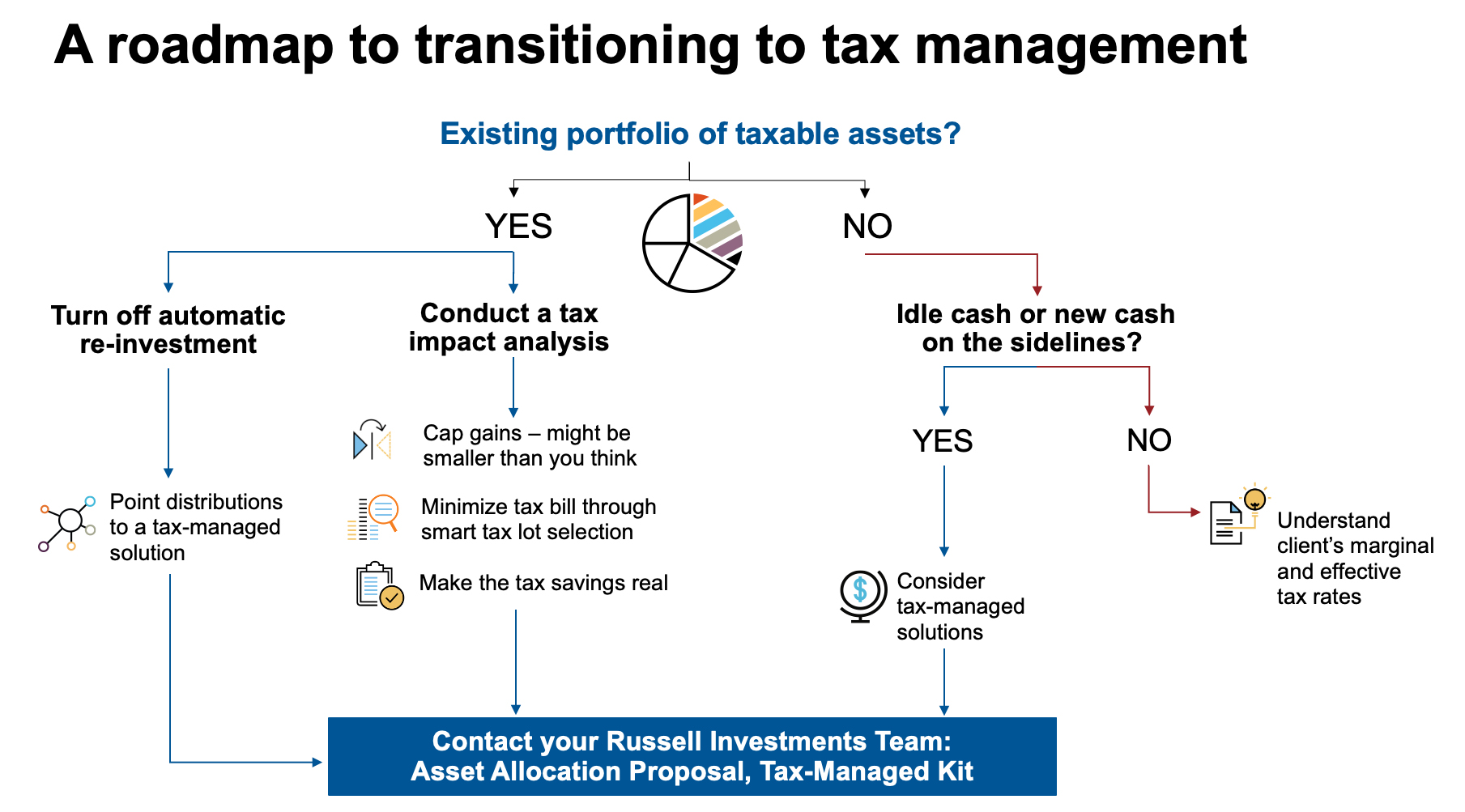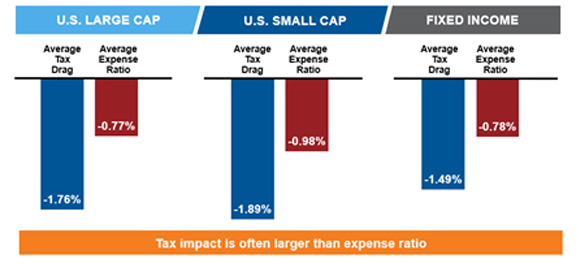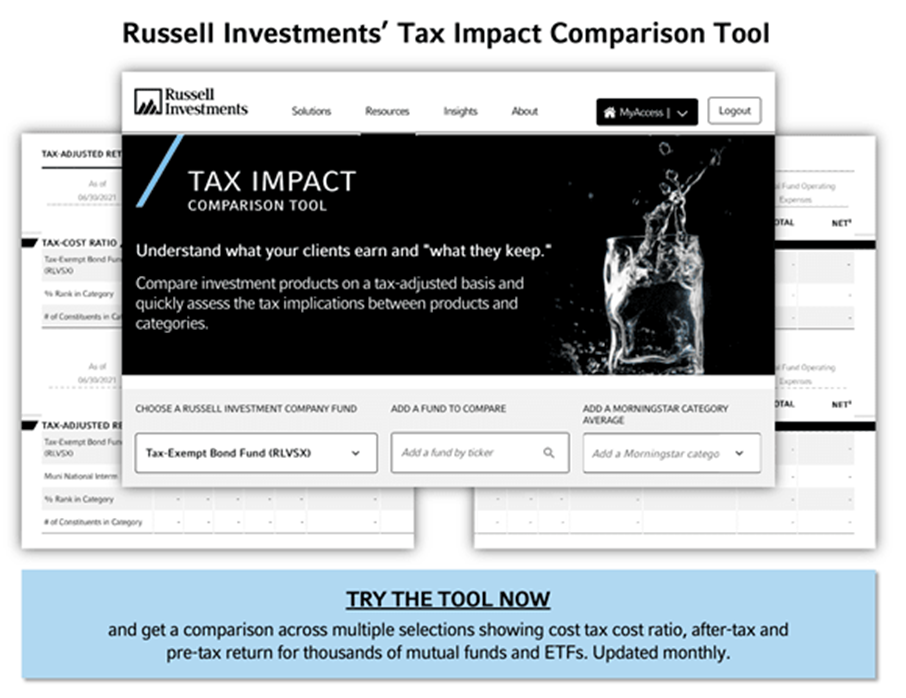The 4 A’s of preparing for capital gains season
Executive summary:
- Taxes can have a significant and ongoing impact on an investment portfolio
- Advisors can help their clients minimize that impact with a tax-smart approach
- Advisors can prepare for capital gains season now, and potentially maximize their clients’ after-tax return
The economy. Political discord. Inflation. Consumer spending. Geopolitical tension. Wars. Interest rates. Mortgage rates. The actions of the Federal Reserve. There is a lot in the news these days.
What should we focus on? What is most important as we think about our savings, our retirement, and our investments?
It's easy to become distracted by everything that is occurring around us. There's a lot of noise. But the truth is that any of those issues affect us for only a short time. What we should focus on are the things that have a constant impact on us and our portfolios.
An issue that has a constant impact can have a significant and long-term detrimental effect on your savings, your retirement, and your investments. That constant impact is TAXES. As Benjamin Franklin once famously wrote, taxes are as certain as death. When it comes to an investment portfolio, the impact of taxes can be sizable, and can result in permanent capital destruction.
The conversations you have with your clients and the questions they ask are often influenced by what's in the current news cycle. It's up to you to refocus the conversation to something that is also important – more so in fact: the constant tax impact that may quietly be eating away at their investment growth and after-tax wealth. We call that impact "tax drag" because of its potential to hold back an investor's overall returns.
While investors wait for clarity on the events dominating the news, there are actions financial advisors can take to keep the focus on the constant impact of taxes and help clients keep more of what they make. Prepare now for the certainty of capital gains and other taxable distributions from investments. After all, fall/winter is the time of year when most mutual funds post their estimates for capital gains distributions and related taxable events.
And it is not just capital gains that erode after-tax returns. Dividends and interest payments also reduce the after-tax return of both passive and active strategies, and they are paid throughout the year.
So, how can you prepare for these taxable events? Think of these four A's:
| Awareness | Assessment | Action | Advocacy |
1. Awareness
How big of a problem is tax drag? Looking at data across all investment products (active mutual funds, index funds and ETFs) reveals that the returns lost to taxes often exceed the average net expense ratio. It's as though these lost returns have incurred a government-imposed expense ratio.
Awareness of the magnitude of this tax drag can open your eyes to its pervasiveness across your clients’ accounts. We firmly believe reducing this tax drag (financial professional login required) is one of the most compelling ways to justify your fee and showcase your value in working to improve after-tax outcomes.
Return lost to taxes versus fund fees: Three years ending Sept 2023
Taxable investors often focus on the wrong fee
Expense ratio is commonly investors main concern
(Click image to enlarge)
For three years ending September 2023.
Source: Morningstar. U.S. Large Cap: Morningstar U.S. Large Blend Universes average, U.S. Small Cap: Morningstar U.S. Small Blend Universes average, Fixed Income: Morningstar Taxable Bond Universes average. Tax Drag: Morningstar Tax Cost Ratio See appendix for methodology.
Morningstar's tax cost ratio assumes the highest possible applicable tax rates, including the 3.8% net investment income tax. Many investors are not subject to the highest rates. Note that tax drag calculations only apply to taxable accounts.
2. Assessment
While history may not precisely repeat itself, it does provide a valuable indicator of past tax efficiency, particularly in terms of investment returns lost to taxes.
Reading about tax slippage is one thing, but seeing specific tax drag and after-tax return by product really helps in the Assessment process. Our Tax Impact Comparison Tool, which uses Morningstar data, serves as an invaluable resource for evaluating the influence of taxes on investment returns, aiding in making well-informed decisions for taxable accounts. This tool not only reveals the amount of return lost to taxes (tax-cost ratio) but also provides information on after-tax return, pre-tax return, and their relative rank within a peer universe.
(Click image to enlarge)
3. Action
Once you have gained a clear understanding of the tax drag in your portfolios, it is time to take Action. Consider these client scenarios:
- Cash or new money to invest?
With proper awareness and assessment, you should be well-positioned to make informed choices on after-tax return and tax drag for different investment options and the best tax-smart offerings. - Invested in a security or fund that is tax-inefficient or in which the client has lost conviction?
Russell Investments can help you conduct a break-even analysis to understand the possible tax impact of selling the asset and the potential return improvement of transitioning to a more tax-efficient alternative. The analysis can also help make an informed decision about whether executing the transition over time or ripping off the band-aid may make more sense. This may guide those considering pulling gains forward in advance of any potential tax rate increases.
Moreover, for current investments that lack tax efficiency, it's advisable to consider turning off automatic reinvestment of capital gains, dividends, and income. No reason to put new money into the same tax-inferior alternative.
(Click image to enlarge)

For illustrative purposes only
We believe tax-managed funds are a natural recipient of these scenarios.
4. Advocacy
Our annual Value of an Advisor study reveals that one of the most significant value-added benefits advisors can provide in their client relationships is helping clients reduce the impact of taxes. Tell your clients what you are doing to improve their after-tax outcomes.
Demonstrate Advocacy to clients and prospects by helping them understand how you work to improve their after-tax investment outcomes. Avoid using industry-specific jargon such as basis points, standard deviation, and percentage returns. Instead, use real dollars and cents when showing clients the difference between tax-smart and tax-agnostic investment options. This approach will resonate much more effectively with them.
Your efforts to protect their investments from the impact of taxes have the potential to go a long way toward strengthening the relationship. Advocate for the valuable work you do on their behalf.
The bottom line
Refocus and redirect current client discussions to a more productive focus by homing in on the constant factor: the relentless tax drag that erodes retirement savings and investment returns. While next year's news cycle will bring new topics, the enduring influence of taxes will persist over time. As we approach year-end, the capital gains and distribution season is upon us.
Addressing the potential tax impact of these gains on investment returns today can help make the capital gains distribution season this fall and winter a productive part of your client engagement. At Russell Investments, we offer a range of tools, in-depth analysis, subject matter experts and dedicated sales and service teams to empower your success in this area.


